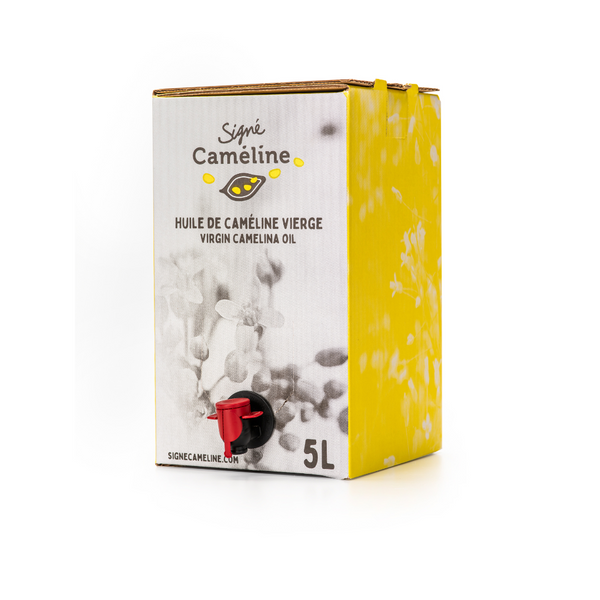Camelina, the local solution to olive oil
•Posted on June 20 2024

TEXT BY: Caribou
PHOTOS BY: Alexis Boulianne

— Why should we adopt camelina oil?
The number of miles traveled from field to grocery store is minimal. Also, there are positive impacts on the ten other farming families with whom we produce camelina.
Above all, the taste is super interesting. With virgin camelina oil, we are more hazelnut and asparagus. With the roasted oil, we have notes of roasted peanut and roasted sesame. It's so good!
It is an oil that mixes wonderfully with vegetables and fish. It is also perfect for the air fryer, as it tolerates up to 245°C (475°F). The oil is stable for cooking at high temperatures thanks to its abundant antioxidants.
In addition, as there are problems these days around the cultivation of olive trees, the price of olive oil is increasing sharply; camelina oil is becoming a more affordable option. Of course, the taste is different, but at the same time, 30 years ago, we didn't consume a lot of olive oil in Quebec.
The camelina accompanied humans for millennia, but we have forgotten it. Historically, camelina oil is to northern Europe what olive oil is to the south.

— What has the journey been like since you started growing and processing camelina?
Our first commercial harvest was in 2015, but before that, there were eight years of research and development. During these eight years, there were ups and downs, but we were able to develop our knowledge of camelina cultivation and oil production.
Currently, in addition to the interest in our camelina in Quebec, we are developing markets abroad. In Asia, people are looking to eat healthily with oils with omega-3, and our oil contains 35%. So there's a lot of interest there.
We are also developing various derivative products which are not yet on the market.
— What makes camelina cultivation so interesting?
Camelina is grown in Montérégie as well as in Témiscamingue. It tolerates the cool temperatures and spring frosts of this northern region well, which makes it an interesting addition to the crop rotation. Camelina cultivation improves biodiversity and soil health and represents additional income for agricultural farms.
In Montérégie, with the increasing cost of land, we integrate camelina into winter cultivation with sowing in September and harvest in June, which allows a second short crop. In a four-year rotation, we observe an increase in crop yield the following year.
We are in our most beautiful field ever. It was sown on September 6, 2023; the camelina grew, overwintered and emerged in spring. Since it was so early and its root system developed well, it gave weeds no chance. It therefore acts as a natural pesticide, while protecting the soil against erosion. It also helps keep the soil alive.
All our agricultural techniques aim for as little intervention as possible. We follow the forces of nature; it creates biodiversity in the soil and provides a source of pollen for insects. Kindness for Signé Caméline involves the health of the planet as much as that of humans.
To see the article: https://cariboumag.com/articles/la-cameline-la-solution-locale-a-lhuile-dolive/?fbclid=IwZXh0bgNhZW0CMTEAAR2owJXqpWW6yd8kwPCsfLRsRtd3FYpxAi80YBIAz-lpoyvXL9wzRNW4r_k_aem_ZmFrZWR1b W15MTZieXRlcw



